The Western Digital Blue (1TB) SSD Review: WD Returns to SSDs
by Billy Tallis on October 11, 2016 8:00 AM EST- Posted in
- SSDs
- Storage
- Western Digital
- SanDisk
Mixed Random Read/Write Performance
The mixed random I/O benchmark starts with a pure read test and gradually increases the proportion of writes, finishing with pure writes. The queue depth is 3 for the entire test and each subtest lasts for 3 minutes, for a total test duration of 18 minutes. As with the pure random write test, this test is restricted to a 16GB span of the drive, which is empty save for the 16GB test file.
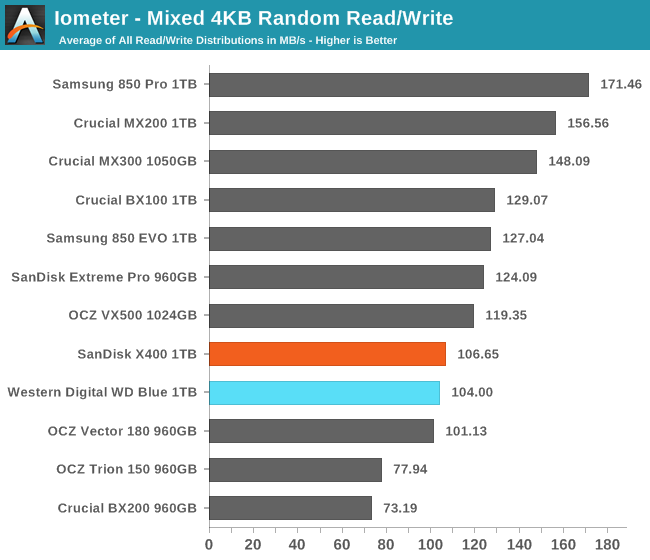
Like the SanDisk X400, the WD Blue performs better on the mixed random I/O test than competing planar TLC drives and about the same as the slowest MLC drives.
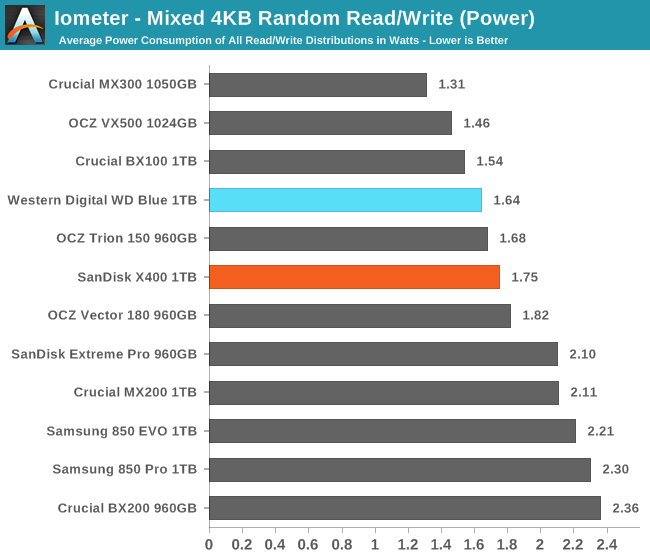
The WD Blue once again slightly raises the efficiency standards for planar TLC, but is still nowhere near as efficient as 3D TLC or MLC.
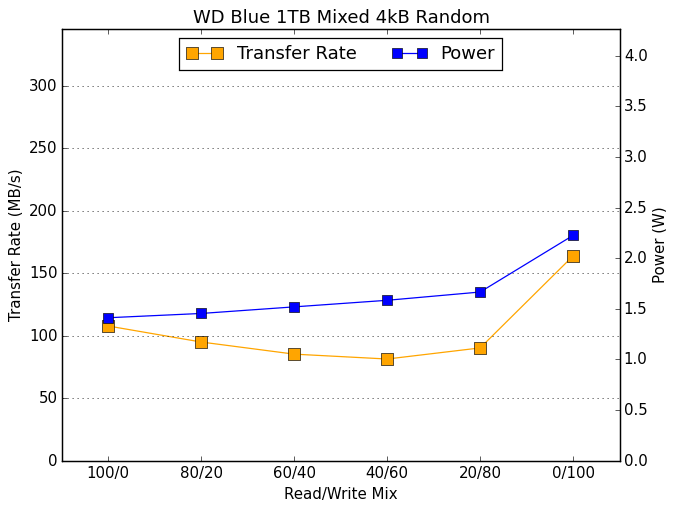 |
|||||||||
The WD Blue starts the mixed random I/O test with a pretty good random read speed, but performance declines as writes are added to the mix until near the end of the test, where the jump in the last segment of the test is not as large as what most drives experience.
Mixed Sequential Read/Write Performance
The mixed sequential access test covers the entire span of the drive and uses a queue depth of one. It starts with a pure read test and gradually increases the proportion of writes, finishing with pure writes. Each subtest lasts for 3 minutes, for a total test duration of 18 minutes. The drive is filled before the test starts.
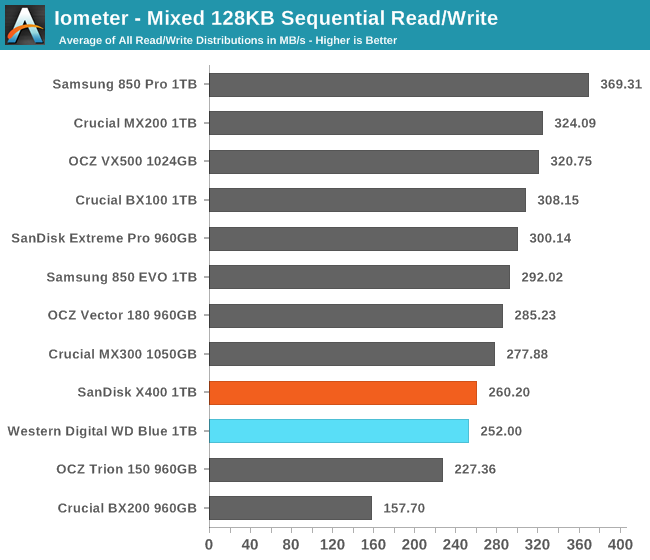
The WD Blue performs above average for a planar TLC SSD on the mixed sequential I/O test, but is not competitive with MLC or 3D TLC.
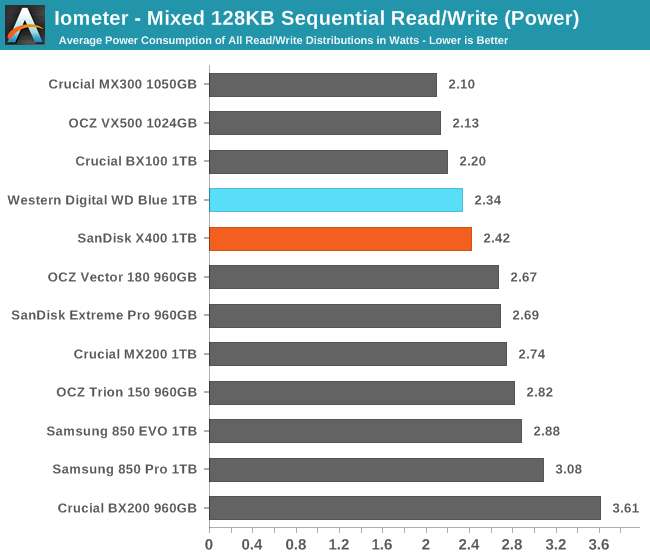
In absolute terms the WD Blue has pretty low power draw on this test, but the efficiency is not close to setting a record.
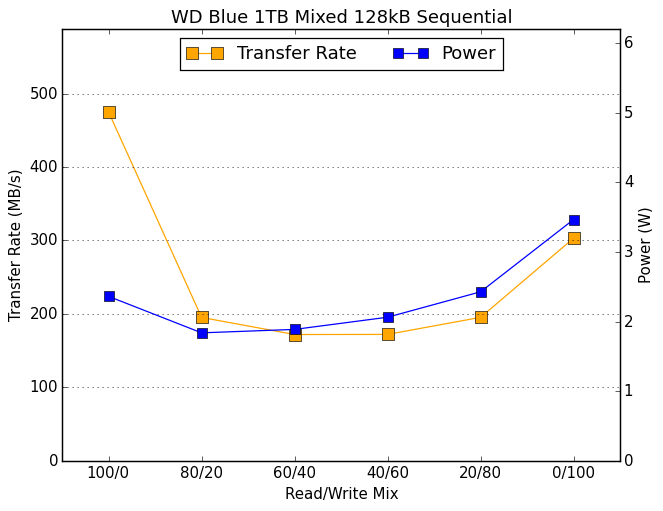 |
|||||||||
The WD Blue's U-shaped performance curve across this test is fairly typical, but the dropoff at the beginning is relatively steep and the minimum is a bit on the low side.










75 Comments
View All Comments
DigitalFreak - Tuesday, October 11, 2016 - link
I'd pay the extra $6 for the 1TB 850 Evo, which preforms much better.vladx - Wednesday, October 12, 2016 - link
I'd rather pay $50 less for the Sandisk X400 than to spend an addiitional $56 for some benchmark points that are hardly relevant to real world experienceTheinsanegamerN - Wednesday, October 12, 2016 - link
in a heavily used system, those "extra points" can mean more then just a high score.vladx - Wednesday, October 12, 2016 - link
For a heavily used system, you buy a Samsung 850 Pro or PCIe SSD.Impulses - Wednesday, October 12, 2016 - link
The EVOs do go on sale somewhat often... I can see paying a premium for them either way, but I definitely wouldn't pay an extra large premium for the Pro, at that point you might as well go PCI-E/M.2 IMO... Unless it's a really fringe case where you need both the fastest+largest consumer drive available and price (or leaving performance on the table) isn't a concern.Bullwinkle J Moose - Saturday, October 15, 2016 - link
Extra large premium for the Pro???I require a minimum of 160GB for my Boot Drives in my test Rigs so I need 250 - 256GB SSD's minimum
Lets look at the Huge Premium at Newegg for the 256GB 850 Pro shall we
Oct 15 2016
850 EVO / 250GB $99.99 OUT OF STOCK
850 Pro / 256GB $123 IN STOCK
850 EVO warranty 3 years
850 Pro warranty 10 years
850 EVO TLC Nand
850 Pro MLC Nand (40nm process)
Firmware problems
850 EVO ???
850 Pro None
Would anyone here spend more than the difference in price between these 2 SSD's just for an extended warranty on an EVO?
The better buy is the Pro!
It also has much better compatability with various Operating Systems than PCIe / M.2 SSDs
I'm using mine for Windows XP / Windows 8.1 / Windows 10 and Linux Mint
Try running any OS that is not a DRM Spyware Platform on your precious M.2 drive
Bullwinkle J Moose - Sunday, October 16, 2016 - link
Apparently it was only the 840 EVO that had firmware problems so the 850 EVO firmware appears to be fine and neither the 850 EVO or Pro has burst into flames yetTheinsanegamerN - Monday, October 17, 2016 - link
Linux loves my 950 pro. So yeah.Magichands8 - Tuesday, October 11, 2016 - link
What a disappointment. Yet another low capacity, highly priced SSD permanently crippled by the SATA interface... just like all the other SSDs we've been presented with for years and years. Not touching this with a 10 foot pole.Lolimaster - Wednesday, October 12, 2016 - link
Unless you edit videos, no one noticies the 2GB/s+ speeds unless for e-pen1s rights.